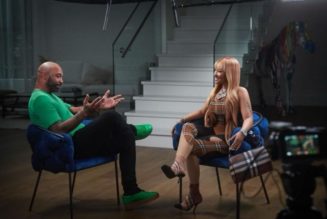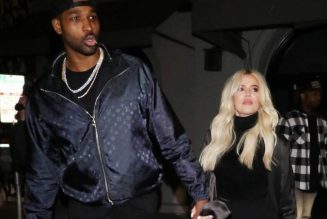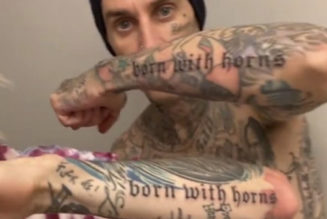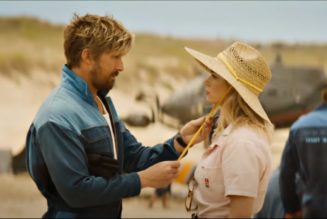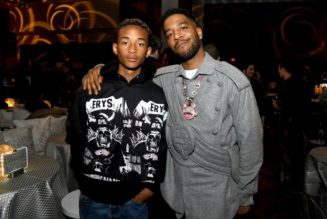
Manon has released songs in a variety of genres so far, including trap, emo rap, alternative rock and dream pop, always staying on top of the current trends. The young artist sat down with Billboard Japan to talk about her choice of style and theme for her latest single in this new interview.
Since when did you want to become the kind of artist that you are now?
Since I was in elementary school. I’ve always loved music. My father is French and my mother is Japanese, so I listened to all kinds of music from not only Japan, but also France and Europe as well, and naturally began to think that I wanted to try doing it too. My mother ran her own clothing store and she played a lot of David Bowie there because she loved his music, and when I was little I used to watch the DVD that came with his greatest hits album.
What was it about David Bowie that fascinated you from such a young age?
The way he takes on different kinds of expression depending on the time period. Glam rock, country music, dressing up like a man from outer space… he’s like a different person each time. I also love his fashion. In the music video for “Life on Mars?” he wears sky-blue eyeshadow and a matching suit, which I think is stunning.
If you had to introduce Manon the artist, how would you describe her?
Someone who changes like a chameleon. You can tell from the way my previous work and this one are completely different. It might be that I get easily excited about something but get tired of it quickly as well.
Your latest single “Galchan Mode” is a unique number that blends hyperpop with Shibuya “gal” culture. When did you take interest in the hyperpop scene?
I’ve always loved hip-hop, and with hyperpop, I don’t recall any specific instance that got me into it, just that I happened to notice I listened to a lot of that kind of music. I’m not very knowledgeable about genres, but I listened to acts like 100 gecs and saw that they were categorized as “hyperpop” in the playlists. I collaborated with Kero Kero Bonito before, and she was featured in 100 gecs’ “ringtone” remix with Rico Nasty and Charli XCX, and I love those artists as well. I guess that’s where I first encountered music like that.
So you weren’t intentionally trying to break new ground, but got into it in a natural way?
It did feel a bit different from the music that I’d been listening to up till then. The vocals, for one. And although there are tracks that use a lot of guitar sounds in emo rap, the guitar in hyperpop is more distorted. It’s also enigmatic, in that there are many artists whose identities remain a mystery, and some fiddle with their formants so they can’t be categorized by gender. I think it’s a borderless genre in many ways. And when I noticed that my playlists were filling up with songs like that, I realized I liked the genre and decided to take a shot at it with my own music.
How did the production of “Galchan Mode” proceed?
I’m not allowed to say yet, but I made a song with a friend that was close to hyperpop in taste. And that made me want to try it myself even more, so when Lil’Yukichi agreed to make the track for me, I sent him some music like that as reference and he came up with this awesome song.
Why did you choose “gal” culture as the motif?
When I heard the trance-like synthesizer in the hook, I thought, “This is para para!” and decided to go full-on “gal” culture with the lyrics as well. This cultural trend is often referred to as “gyaru” and not “gal” outside of Japan, and it remains popular in some circles. It’s also enjoying a bit of a revival in Japan as well… Kiko Mizuhara’s brand OK and the women’s footwear brand Esperanza collaborated on some products inspired by 90s “gal” culture and used real-life “gals” as models in the lookbooks, for example. So I did some digging in “gal” term dictionaries and the fashion brands that catered to that style, and also went back and read a lot of the blurbs on “gal” magazine covers.
You’re currently 19 years old. The peak of “gal” culture was between the 2000s to the 2010s, so you were too young to actually experience it. What about this fad do you find interesting?
Social media didn’t exist, yet these girls flocked to Shibuya to hang out, which seems so novel to me. How did they get together? How did those “gal” circles come about? It’s so mysterious. I guess they gathered information through magazines? I think those “gals” at the time were unique beyond comparison. Now, different types of girls consider themselves to be “gals,” so the definition is becoming diverse. Some are “gals” in their way of thinking.
The word “galchan” comes across as pretty distinct as well.
“Gal” by itself sounds a bit too blunt, don’t you think? But “galchan” sounds cute. Adding honorific suffixes like “-chan” and “-kun” are particular to Japanese culture, so I thought that element should be there as well.
Isn’t it also the first time you’ve used so much English in your lyrics?
Yes. Partly because hyperpop is more popular outside of Japan, and also because I want to reach out more to global audiences. But the song also has lots and lots of “gal” terms.
How did the vocal recording go?
I recorded all of it at home, and tried out different ways of singing. It was fun. I’d never really been too conscious of it before, but this time I changed my way of singing depending on the phrase. For example, I did the “Show window no Balenciaga” part kind of in a dumb-sounding way. Hyperpop uses strong effects on the vocals, so I tried to add more variety to it than usual.
Were there any challenging parts?
The melody of the hook. It’s the highlight of the song, so I did it over many times. It was the same with my song “18,” too. I tend to get stuck on the hook. I only began composing my melodies last year, so I’m still getting used to it.
This was your first time recording at home, right?
Yes. I did it because I have this image of hyperpop artists making their music at home. I don’t have soundproofed walls or anything, so I brought all my recording gear into a closet and sang there. I figured my clothes would absorb the sound.
The 3-D avatars on the CD jacket are retro in taste. How did you end up with those visuals?
I asked a 17-year-old visual artist [Anson C. Shota] based overseas to design them. My avatar is also featured in the music video. Do you know a pachinko machine called “Umimonogatari”? I was really into that at one point. By that I don’t mean I was into pachinko, just the character visuals of that particular series. It’s kind of psychedelic, don’t you think? I wanted this single to look like that.
How did you meet this artist?
They drew Cold Hart fan art, and I saw the rapper himself sharing their illustrations on Instagram. I thought, “Wow,” and looked at their profile and it said “17 (years old).” Apparently they draw as a hobby, but I thought the illustrations went beyond that level and were so cute. That’s why I asked them to work with me.
What styles of expression do you want to try in the future?
My next song is a bit different from this one. It’s a lot more intense than my previous works, kind of like rap rock. “Galchan Mode” is super pop, but my next song will be a bit darker in tone. “18” was also kind of a moody number, but my next one isn’t like that, either. I’m sure I’ll keep on changing.


